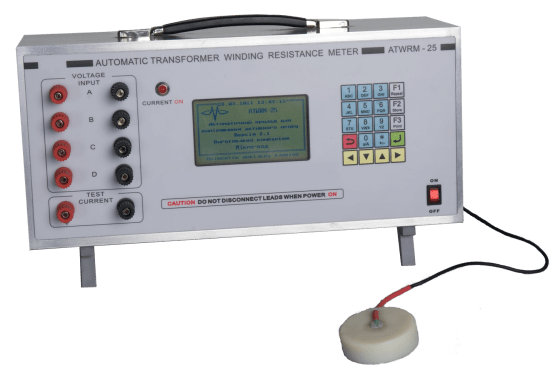
These are specialized instruments used to measure the resistance of windings in transformers and other electrical devices. The winding resistance of a transformer is a critical parameter for assessing the condition and performance of the transformer. Measuring winding resistance helps in detecting issues such as loose connections, damaged windings, or other problems that can affect the transformer’s efficiency and reliability.
Applications
Routine Maintenance and Testing: Regular measurement of winding resistance is a fundamental part of routine maintenance for power transformers. By monitoring the resistance over time, maintenance personnel can detect early signs of problems such as loose connections, deteriorating insulation, or damage to the windings. This helps in preventing catastrophic transformer failures.
Commissioning: When a new transformer is installed, it is essential to verify the integrity of its windings. Automatic resistance meters can be used during commissioning to ensure that the transformer is correctly assembled and its windings have the expected resistance values.
Diagnostic Testing: When a transformer experiences an unexpected failure or performance issue, winding resistance measurements can help diagnose the problem. Abnormal resistance values may indicate a specific fault, which can then be addressed.
Oil-Immersed Transformers: Transformers filled with oil require special testing procedures, and winding resistance measurements are crucial in assessing their condition. Changes in resistance can be indicative of issues within the transformer’s oil-filled tank.
Tap Changer Testing: Automatic resistance meters can be used to test tap changers in transformers. Tap changers are mechanisms that adjust the turns ratio of the transformer to regulate output voltage. Accurate resistance measurements ensure the tap changer is functioning correctly.
Substation and Grid Maintenance: Power utilities use these meters to maintain and monitor transformers in substations and throughout the electrical grid. Ensuring the health of transformers is critical for grid reliability and the delivery of electricity to consumers.
Quality Control in Manufacturing: Transformer manufacturers use these instruments to verify the quality and consistency of their products. Resistance measurements are a critical part of quality control for newly manufactured transformers.
Research and Development: In research settings, these meters can be used to test the performance of transformers under various conditions and loads. This data is valuable for designing more efficient and reliable transformers.
Historical Data Comparison: By regularly measuring winding resistance and maintaining historical records, engineers can compare current measurements with past values to identify trends and potential issues before they lead to failures.
Safety: Accurate resistance measurements contribute to the safety of electrical systems. Detecting issues early helps prevent dangerous electrical faults that can result in fires, power outages, or other safety hazards.


